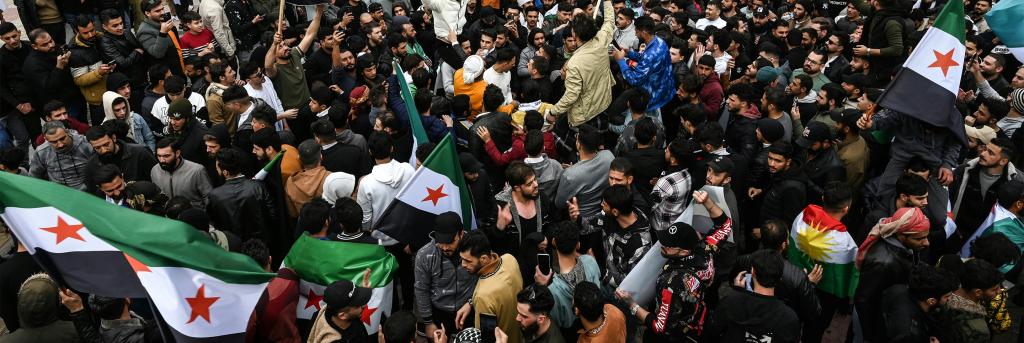In early December 2024, Hayat Tahrir al-Sham (HTS), a group formerly linked to Islamic State and al-Qaeda, seized control of the Syrian capital, Damascus, in coordination with other armed factions from across the country. In the weeks that followed, HTS representatives engaged in diplomatic outreach, meeting with Arab and Western diplomats, travelling across the Middle East and presenting themselves as Syria’s new government. These efforts coincided with extensive discussions on Syria's future, including debates on how to engage with the new authorities, the potential lifting of existing sanctions, and strategies to revive the country’s economy. While many questions about Syria's trajectory remain unresolved, there are already early lessons and insights into what the future might hold.
The first lesson is that this victory was unexpected, though recent developments in the Middle East and Ukraine over the past year help explain part of it, alongside the broader trajectory of the armed opposition for the past five years.
The short-term reasons for the opposition’s victory are tied to the wars in Gaza and Ukraine. In October 2023, Hamas launched an unprecedented assault on Israel along the Gaza border, triggering a chain of events that destabilised the Middle East. Israel responded with a devastating war on the Gaza Strip, which continues to this day. The conflict drew in Hamas’ allies, particularly Hezbollah in the north, as well as Iran, further escalating regional tensions. This regional escalation weakened Iran and its allies, as Israel struck them with severe force over the past year throughout the Middle East. Hezbollah, in particular, suffered significant setbacks, including the loss of many of its top leaders over the past few months. Hezbollah’s diminished capacity left it unable to maintain the same level of support for Assad’s regime in Syria, weakening the frontlines with the armed opposition. Similarly, Russia’s war in Ukraine has consumed much of its resources, limiting its ability to project power in Syria as it had since its military intervention in 2015. This combination of regional and global dynamics contributed to the changing balance of power in Syria.
The success of HTS and its allies is also the result of a longer trend. Since breaking ties with al-Qaeda in 2016, HTS has pursued a new political-military project in northwestern Syria, the primary region under armed opposition control. This effort includes the establishment of a new civilian government to administer the population in a relatively non-ideological manner, alongside the restructuring and consolidation of the armed opposition’s forces. Rather than a loose coalition of competing factions battling each other as well as the regime, the armed opposition has, over the past five years, evolved into a more cohesive and unified structure. It increasingly resembled a "state-in-being" — albeit unrecognised internationally — that appeared more functional and state-like than Assad's regime, which failed to reform or rebuild effectively after reclaiming control over most of Syria by the end of 2016.
However, the story does not end here. The biggest challenge lies in what comes next, particularly regarding the issue of sanction relief. Syria remains under a wide array of sanctions imposed by Western states and the United Nations, which severely impact key sectors of the economy, from the central bank to the energy sector. Discussions are underway on the possibility of general licensing, which the United States recently granted, and the potential lifting of sectoral sanctions on Syria. These measures are critically important to enable the new authorities to revive the economy and begin addressing the pressing needs of the population.
Beyond the issue of sanctions, the task of rebuilding Syria looms large. The new authorities have proposed the initiation of a national dialogue to pave the way for the formation of committees to address key issues, including the drafting of a new constitution. This raises critical questions about the country's future: What kind of state will Syrians agree upon? What balance will be struck between some degree of centralisation and federalism, particularly in ensuring full inclusion of ethnic and religious minorities? What forms of elections and lawmaking will emerge? Although Syria had the beginnings of a democratic tradition before the Ba’ath regime took power, that legacy has long since faded. Still, a vibrant civil society has evolved, both within opposition-controlled areas and among the Syrian diaspora. These groups are likely to play an essential role in shaping the country's future. The question remains: To what extent will HTS allow these forces to participate meaningfully, beyond mere token involvement under its control? Besides, the stance of foreign states will be pivotal. How they engage with this process will determine the level of international legitimacy, support, or opposition the new authorities will face as they attempt to rebuild the country.
In the meantime, security remains a top priority. The new authorities, primarily composed of HTS and its allies, are generally well-disciplined and structured. However, they must also contend with a variety of other groups, many of which are local and driven by their own interests, not necessarily operating fully under centralised control. Bringing these factions together to form unified security services and a cohesive national army will be a significant challenge. They also need, without waiting, to maintain security across the entire country, despite currently lacking the manpower to do so. This is crucial not only to ensure stability for Syrians, including those returning from abroad, but also for the protection of minority groups who fear reprisals from armed factions, especially for crimes committed by former regime supporters.
A last pressing issue is the presence of hundreds of foreign fighters who have participated in the last military campaign, and many of whom adhere to a stricter vision of how Syria should be ruled with Islamic law. While HTS has previously managed to marginalise and control most foreign-led groups and sidelined the most radical among them, their presence continues to raise concerns. Foreign governments remain wary about the potential implications for Syria’s stability and security, with some even linking the possibility of sanction relief to how effectively this issue is addressed.
Finally, while these political questions are crucial, it is also important to stand with the Syrians during this critical period. Despite the odds, Syrians have managed to overthrow a dictatorship that had ruled them for 50 years and was one of the harshest regimes in the region. While the road ahead remains difficult, it is important not to overlook the sense of relief and celebration that comes with its end. This includes the liberation of tens of thousands of prisoners and the reunification of Syrians who had been unable to return home for years, sometimes for over a decade. Rebuilding the country will take time, but at least now Syrians have the opportunity to start anew.
Learn More on the Topic
Dr Jérôme Drevon recently published From Jihad to Politics, which explores why Jihadis rose to prominence in the Syrian conflict while factions affiliated with the Free Syrian Army struggled to gain traction. Drawing from his field research and interviews with these groups’ leaders in rebel-held Syria, Drevon’s book discusses how these insurgents transformed and politicised over the years, drawing important lessons and potential trajectories of the Jihadi movements beyond Syria.



